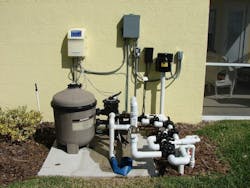Membrane Filtration for Water and Wastewater
This article was updated for clarity and discoverability July 27, 2021.
Membrane filtration, widely used in chemical and biotechnology processes, is already established as a valuable means of filtering and cleaning wastewater and industrial process water. More recently, tubular and spiral membrane plants have begun to be used to filter impurities from drinking water in regions where conventional treatment proves to be uneconomical.
Pressure Driven Membrane Filtration
Although there are a number of different methods of filtration that incorporate membrane technology, the most mature is pressure driven membrane filtration. Membrane filtration relies on a liquid being forced through a filter membrane with a high surface area. There are four basic pressure driven membrane filtration processes for liquid separations. These are, in ascending order of size of particle that can be separated: reverse osmosis, nanofiltration, ultrafiltration and microfiltration.
The use of reverse osmosis is well-established for desalination of drinking water and the production of deionized water for process use. Ultrafiltration and microfiltration, which-unlike reverse osmosis and nanofiltration-utilize porous membranes, are now becoming increasingly common in water and wastewater treatments.
PCI Membrane Systems (PCI MS), based in Hampshire, England, has installed a number of membrane plants in the UK and overseas for both industrial and municipal use. Steve Morris, PCI MS's business development manager, explains the fundamental principles of membrane filtration, "In its simplest form, the membrane is used to separate water or process liquid into two parts: the retentate, or concentrate, and the permeate or filtrate." Depending upon the desired separation, membranes can be used either to trap unwanted impurities or to concentrate materials.
Re-use of feedwater is an important consideration in a number of continuous processes such as pulp and paper manufacture. Recovery of raw materials also is becoming a major issue. At a leading chemical company in Liverpool, a membrane plant was designed and installed to recover an aliphatic compound from the effluent stream. The recovered product is recycled back into the process stream, while the CoD of the resulting wastewater is reduced significantly.
Depending on the application, the membranes are fitted inside a housing of either stainless steel or lightweight ABS, as in the case of the new C10 ultrafiltration module. The C10 contains a larger membrane area than previously available allowing the use of tubular ultrafiltration to be more economically viable than before. In parts of the water industry, the benefits of tubular membranes are well understood.
Ease of operation, minimal maintenance, elimination of prefiltration and the ability to self clean the membranes were all factors that prompted the adoption of the Fyne Process in remote locations in Scotland. The Fyne Process removes dissolved organic solids from drinking water.
Tubular Membrane Filtration vs. Spirally-Wound Membranes
Tubular membrane filtration is the first choice for applications where there are high levels of solids, viscous liquids or where cleaning and maintenance are issues. For higher capacity water and wastewater applications, a different type of membrane configuration is sometimes favored. Spirally-wound membranes provide a higher packing density than tubular and are the more economical alternative in some cases. However, prefiltration is necessary because the small space between layers in the spiral can easily become blocked by suspended solids. Spiral wound membranes can be used across the filtration spectrum.
In Scotland, spiral membranes also are used in Fyne Process plants where high throughput is required and the self cleaning capability of tubular units is not an issue, as is the case at Bunnessan on the Isle of Mull. In other areas of municipal treatment such as disinfection, systems using hollow fiber microfiltration membranes are available. This area of the industry is becoming increasingly important.
Membrane filtration perform two tasks, as outlined by PCI MS's Steve Morris. On the one hand they can be used to concentrate or recover valuable material while the process water is allowed to flow through the membrane. Alternatively, they effectively remove contaminants from waste streams allowing the water to be recycled to the process or discharged to the drain or the river.
Ultrafiltration & Microfiltration
Ultrafiltration, which typically operates at pressures of between five and 15 bar, is widely used in chemical separation processes because it can separate species according to molecular size. Microfiltration however, separates according to particle size.
Organic membranes treating streams with high levels of solvent or with a wide pH range have been developed. In some cases, organic membranes are not suitable for ultrafiltration, and microfiltration and ceramic membranes are used. Although capital cost is usually higher, membrane life is often longer than with organic material.
Because of the diversity of applications in both industrial and municipal water filtration, consulting services are available to help evaluate the feasibility of using membranes, selecting the most appropriate membrane type in each case. The membrane material, geometry and housing construction all need to be considered. A pilot plant trial often is necessary before plant design and engineering is completed. Hiring pilot plants for short periods for on-site development work is an economical way of developing the membrane process.
